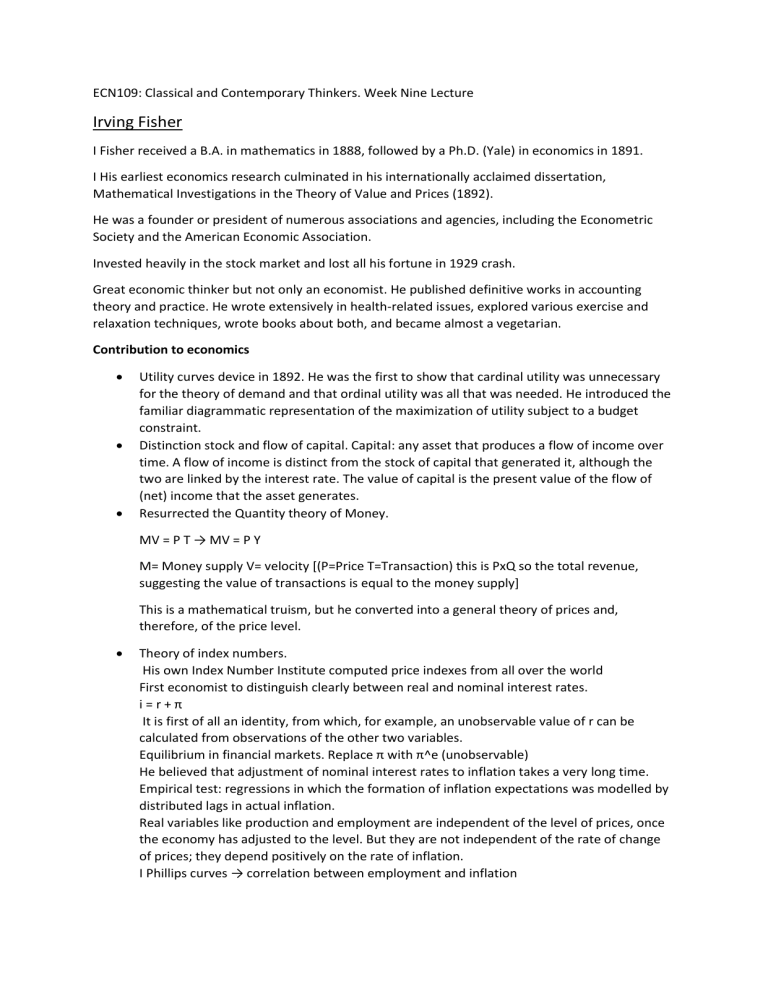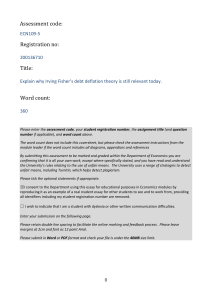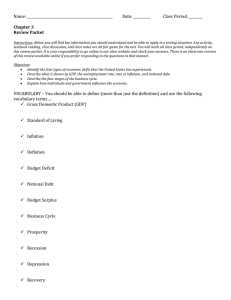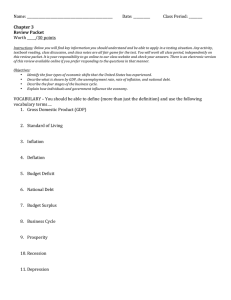
ECN109: Classical and Contemporary Thinkers. Week Nine Lecture Irving Fisher I Fisher received a B.A. in mathematics in 1888, followed by a Ph.D. (Yale) in economics in 1891. I His earliest economics research culminated in his internationally acclaimed dissertation, Mathematical Investigations in the Theory of Value and Prices (1892). He was a founder or president of numerous associations and agencies, including the Econometric Society and the American Economic Association. Invested heavily in the stock market and lost all his fortune in 1929 crash. Great economic thinker but not only an economist. He published definitive works in accounting theory and practice. He wrote extensively in health-related issues, explored various exercise and relaxation techniques, wrote books about both, and became almost a vegetarian. Contribution to economics Utility curves device in 1892. He was the first to show that cardinal utility was unnecessary for the theory of demand and that ordinal utility was all that was needed. He introduced the familiar diagrammatic representation of the maximization of utility subject to a budget constraint. Distinction stock and flow of capital. Capital: any asset that produces a flow of income over time. A flow of income is distinct from the stock of capital that generated it, although the two are linked by the interest rate. The value of capital is the present value of the flow of (net) income that the asset generates. Resurrected the Quantity theory of Money. MV = P T → MV = P Y M= Money supply V= velocity [(P=Price T=Transaction) this is PxQ so the total revenue, suggesting the value of transactions is equal to the money supply] This is a mathematical truism, but he converted into a general theory of prices and, therefore, of the price level. Theory of index numbers. His own Index Number Institute computed price indexes from all over the world First economist to distinguish clearly between real and nominal interest rates. i=r+π It is first of all an identity, from which, for example, an unobservable value of r can be calculated from observations of the other two variables. Equilibrium in financial markets. Replace π with π^e (unobservable) He believed that adjustment of nominal interest rates to inflation takes a very long time. Empirical test: regressions in which the formation of inflation expectations was modelled by distributed lags in actual inflation. Real variables like production and employment are independent of the level of prices, once the economy has adjusted to the level. But they are not independent of the rate of change of prices; they depend positively on the rate of inflation. I Phillips curves → correlation between employment and inflation Irving Fisher’s theory of capital and investment was introduced in his Nature of Capital and Income (1906) and Rate of Interest (1907), although it has its clearest and most famous exposition in his Theory of Interest (1930) Fisher Separation Theorem: the firm’s investment decision is independent of the owner’s preferences. the investment decision is independent of the financing decision. firm’s financing needs are independent of the production decision. Fisher was also a newspaper columnist for the New York Times I On Wednesday, October 15, 1929, Fisher write: “Stock prices have reached what looks like a permanently high plateau. I do not feel that there will soon, if ever, be a fifty or sixty point break below present levels, such as Mr. Babson has predicted. I expect to see the stock market a good deal higher than it is today within a few months.” I On October 23rd, 1929, Black Wednesday: Dow Jones loses almost 10% in a single day I 4 years later, the broad market was 1/6th of its peak, and Irving Fisher had lost over $10 million. Debt-financed Schumpeterian innovations fuel a boom, followed by a recession which can turn into depression via an unstable interaction between excessive real debt burdens and deflation. When one individual tries to reduce his debt, and he is alone to do so, this attempt will generally succeed. The reason is that his sales of assets to reduce his debt will not be felt by the others, and therefore will not affect the solvency of others. The individual will succeed in reducing his debt. When the desire to reduce debt is driven by a collective movement of distrust, the simultaneous action of individuals to reduce their debt is self-defeating. They all sell assets at the same time, thereby reducing the value of these assets. This leads to a deterioration of the solvency of everybody else, thereby forcing everybody to increase their attempts at reducing their debt by selling assets. Previous theory assumed equilibrium Disequilibrium the rule in economy and finance markets. Key disequilibrium forces are debt and prices. The two key factors which cause depressions are “over-indebtedness to start with and deflation following soon after”. Thus, over-investment and over-speculation are often important; but they would have far less serious results were they not conducted with borrowed money. That is, overindebtedness may lend importance to overinvestment or to over-speculation. The same is true as to over-confidence. I fancy that over-confidence seldom does any great harm except when, as, and if, it beguiles its victims into debt.” When overconfidence leads to over indebtedness, a chain reaction ensues: 1. Debt liquidation leads to distress selling and to 2. Contraction of deposit currency, as bank loans are paid off, and to a slowing down of velocity of circulation. This contraction of deposits and of their velocity, precipitated by distress selling, causes 3. A fall in the level of prices, in other words, a swelling of the dollar. Assuming, as above stated, that this fall of prices is not interfered with by reflation or otherwise, there must be 4. A still greater fall in the net worths of business, precipitating bankruptcies and 5. A like fall in profits, which in a “capitalistic,” that is, a private-profit society, leads the concerns which are running at a loss to make 6. A reduction in output, in trade and in employment of labour. These losses, bankruptcies, & unemployment, lead to 7. Pessimism and loss of confidence, which in turn lead to 8. Hoarding and slowing down still more the velocity of circulation. The above eight changes cause 9. Complicated disturbances in the rates of interest, in particular, a fall in the nominal, or money, rates and a rise in the real, or commodity, rates of interest. Irvin fisher describes the process of debt deflation as the attempts to liquidate assets in order to reduce debts becomes self-defeating as a fall in prices due to everyone selling at once increases the real value of debts. The real cost of borrowing is the nominal interest rate minus the inflation rate, so debt deflation is in fact increasing the real cost of borrowing. Inflation would have helped the debt crisis as it would benefit the borrower against the lenders. Fisher and dis-equilibrium in economics and finance. We may tentatively assume that, ordinarily and within wide limits, all, or almost all, economic variables tend, in a general way, toward a stable equilibrium. Under such assumptions . . . it follows that, unless some outside force intervenes, any “free” oscillations about equilibrium must tend progressively to grow smaller and smaller, just as a rocking chair set in motion tends to stop. . . But the exact equilibrium thus sought is seldom reached and never long maintained. Applications Today MtVt = PtYt Let Yt denote real output in period t, which we can take to be exogenous with respect to the money supply I Pt is the pound price of output, so PtYt is the pounds value of output (i.e. nominal GDP) I 1/Pt is the “price” of money measured in terms of goods I Vt is the average number of times per year that the typical unit of money, Mt, is spent on goods and services. This equation is an identity and defines velocity as the ratio of nominal GDP to the money supply. This is the modern version of Fishers equation and if we treat Y as exogenous then there is a direct relationship between the money supply and the price level. Financial Liberalisation causes discrepancy between the price level and the money supply. The basic quantity theory (real output, real output growth, and the real interest rate independent of nominal things) makes a number of predictions. 1. The level of the money supply and the price level are closely linked 2. The growth rate of the money supply and the inflation rate are closely linked 3. The inflation rate and the nominal interest rate are closely linked The quantity theory seems to provide a pretty good theory of inflation and interest rates over the medium to long run as well as in a cross section of countries. When we consider the short run some problems begin to arise. The shorter-term relationships between money growth and both inflation and nominal interest rates are weak and velocity is not constant and has become harder to predict, particularly since the early 1980s. The quantity theory would suggest that the inflation rate would cause economic growth, so the big gaps implies that the correlation is actually quite weak. However, the theory is still a useful tool to estimate output growth however it is mostly useful to see how trends will even out In the long term and not to make short term predictions. He focused on the meltdown of financial markets, the devastating effects of a downward spiral connecting the deflation of assets and goods prices, the process of deleveraging by households and firms, and contraction of economic activity. Leverage + Financial innovation + Easy Money = Financial crisis Originate and distribute banking model: Banks were innovating by financing themselves not through deposits but through markets like the repossession and money market. This brought shorter maturity on the liability side and on the financial side. The older mortgages generated by the old banking systems were sold out to third parties like pension funds and financial investors bought the bonds which generated the problem that the banks no longer cared about the loans and thus far didn’t monitor them closely. Lax lending standards meant the banks did not correctly assess the amount that people could take out in debt so often found people could not pay back loans. Loose Monetary policy (Greenspan put) originated from the 2001 .com crash where the equity markets crashed leading to the federal reserves decided to aggressively cut the interest rate which was much lower than what the economy required. This was in an aim to boost the market however it causes a further cycle of crashes. The amount of times of your income that you could borrow began to skyrocket in 2006, this meant income was rising slower than potential borrowing rates due to the relaxation of lending standards which increased debt to income ratio. Factors contributing to the ability to borrow more and more were: 1. Slowly rising income 2. Lenders being willing to allow much higher debt-to-income ratios 3. Falling interest rates 4. Interest-only mortgages and no money down (100%+ mortgage) This created a shock in 2007/8 which brought down in an economic crisis. Here you can see how the economies compared to when Fisher was living through an economic collapse. Monetary Policy - Reducing interest rate is a limited instrument (zero bound) provide liquidity enlarging central bank balance sheet (quantitative easing) Fiscal Policy - avoid demand deflation, substituting private debt with public debt - sustaining demand - limited by problems of sustainability Fisher was concerned about the low level of inflation and he was suggesting reflation to boost the money supply and inject money into the economy. By doing this there is a redistribution of the cost of debt from the borrower to the lender. Monetary responses The first category consists of measures to ensure that the market rate is consistent with the policy rate. The second involves initiatives to alleviate strains in wholesale interbank markets. The third consists of responses aimed at supporting specific credit markets – particularly the nonbank segments – and easing financial conditions more broadly. The last two categories, insofar as they involve operations directed at particular segments of the transmission mechanism over and above the traditional interest rate target, fall under the umbrella of balance sheet policy. Modern Lessons from Irving Fisher 1. Fiscal stimulus is a band-aid. Massive government spending to support the unemployed and prevent the implosion of state and local governments. Beyond that, spending will not stimulate anything, and it has nothing to do with the causes of the crisis or with putting an end to it. 2. Deflation must be halted and reversed, and the credit system restarted. Today, as in the early 1930s, these two parts of the puzzle are tightly interrelated, as Fisher explained. 3. Prevention. We got into this mess because financial development advanced way ahead of not only regulators and government officials.






